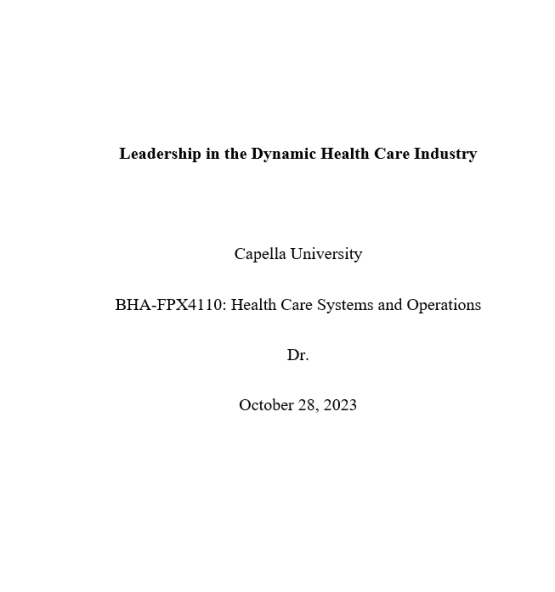


Leadership in the Dynamic Health Care Industry
Capella University
BHA-FPX4110: Health Care Systems and Operations
Dr.
October 28, 2023
Availability:In Stock
Patient satisfaction is a major determinant of competitive advantage in the current health care environment. Organizations and leadership should design and implement structures, processes, and standards for achieving strategic priorities that match patients’ expectations. Failure to optimize outcomes increases the risk of declining revenues and lost market share when patients consider alternative providers. Competent leaders play active roles in interacting with patients, monitoring events in the clinical environment, and collaborating with the workforce to enhance patient satisfaction. The leader also involves patient and families in discussing gaps and improvements necessary to achieve organizational goals. This report highlights the need for healthcare providers to have leaders who understand daily operations, communicate and follow-through with employees to enhance competitive advantage.
Patient experience is a critical issue for health care operations. The process influences the care team’s ability to provide timely services, enhance access to information, and communicate effectively with patients and families. In this regard, patient experience means better patient safety, improved clinical outcomes, and desired patient satisfaction scores that boost competitive advantage (Wolf, 2017). Senior leaders are responsible for establishing a sense of direction and mobilizing resources necessary for improving patient experience. Leaders make decisions about procedural excellence and changes leading to organizational success. Qualities and traits align with strategic priorities established to enhance service excellence and increase patient satisfaction. The leader has the intensity and dedication that enable them to set clear expectations and provide instructions for meeting client needs (Wolf, 2017). The leader also engages staff to create a culture guided by commitment to enhancing the quality and safety of patient care. Thus, organizations should ensure they have competent leaders who create, support, and establish direction.
Patient dissatisfaction is a result of multiple administrative, technical, and human-related gaps. The common signs include longer waiting times, delays in returning calls, ineffective payment processing, and negative physician-patient relationship. The various signs reveal gaps in understanding patients’ expectations and responding through well-coordinated and collaborated care (Grocott & McSherry, 2018). Similarly, high dissatisfaction scores mean staff reluctance to manage various aspects of healthcare and embrace patient-centered practices. As such, the care team is unresponsive to events in the current clinical environment where patients demand a bigger role in making decisions across the care continuum.
Failure to make patient satisfaction a strategic priority triggers non-compliance with industry standards, increased malpractice litigation, poor prognosis, and inefficient utilization of resources. The organization fails to achieve the desired profitability due to inaccessible care, absence of comprehensive interventions, and failure to handle an increasing patient traffic (Grocott & McSherry, 2018). Further, the organization and patients experience high rates of unnecessary hospitalization and readmissions that increase cost of care. Thus, patient satisfaction should remain a priority for organizations committed to establishing and sustaining competitive advantage in a complex health care environment.
Reviews
There are no reviews yet.